Thank you for subscribing to Kizuna Box!
The theme of this December box is “Engimono” (The New year’s holiday).
We will make various preparations for the New Year.
First, In December, we will do “O-souji” (cleanup in everywhere).
When the cleaning is over, our house will be decorated in various items to welcome the new year.
For example, a figurine is called “Kadomatsu” decorations at the entrance, or a lease made of straw is called “shime-kazari”.
Next, exchange the lucky charms that were decorated a year ago with new ones.
Because we think the power of lucky charm is thought to run out in a year.
Now, what is “Engimono”? There are various symbols of Japan that have been considered for centuries as a catcher of luck and happiness, wealth, good
fortune, and more.
In Japanese, small items representing said symbols are called “engimono” (lucky charms).
Here are a popular lucky symbol and general represent:
・”Maneki Neko” (the Beckoning Cat): Good Luck & Wealth
・”Shichi Fukujin” (Seven Gods of Luck): Good Luck & Prosperity
・”Mt Fuji” Sacrality & Good Luck
・”Sho-Chiku-Bai” (Pine-Bamboo-Plum): an auspicious
With these lucky charms by your side, we hope you’ll be more ready to tacklechallenges and achieve your goals for this year!
Wishing you all the best for 2020!
The Lifestyle Box
1. Auspicious pattern small plate
“Tai ” (Red snapper) and “Manekineko” (Beckoning cat) (2items/1set)
A small plate with an auspicious symbol.
Good luck seems to come just looking.
Handwash only・No microwave
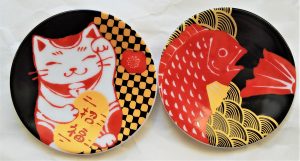
2. “Sakazuki” (Japanese goblet) (each 1 item)
“Sakazuki” is a container for drinking sake.
It is generally used at the time of the celebration or New Year.
Of course, it is recommended to use it on a daily basis.
* Some rims have a golden border and some
3. Plum kelp tea with kelp of the character of “寿” (1P)
Best Before 15 Nov 2020
Common Allergens: None.
The Chinese characters for “寿” is an auspicious character.
And, In Japan, kelp is also treated as an auspicious food.
Put the contents in the bowl and pour 100ml of boiled water.
After a while, the kelp becomes the Chinese characters for “寿”.
4. Mouse ceramic figurine (1 item)
The zodiac of Japan in 2020 is “Nezumi” (mouse).
It is a “Nezumi” motif ornament of earthenware pottery.
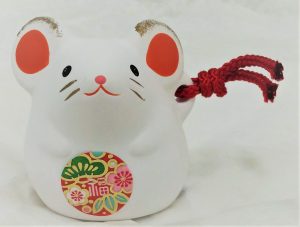
5. Lucky pattern cotton handkerchief (1 item)
It is nostalgic and lucky patterned “Tenugui” (Japanese style handkerchief).
That lucky pattern is “Nezumi” (“Eto” of 2020) and “Sho-Chiku-Bai” (Pine-Bamboo-Plum).
“Tenugui” can be used in various ways depending on the idea.
It is made from 100% cotton in Japan.
6. Mino-yaki Black thunder pattern Japanese plate (1 item)
It’s a small square plate.
The lightning pattern is cool on a black background!
Easy to use size and color for any dish.
Dishwasher safe
<Mino-yaki>
Originated from Gifu Prefecture, Mino-yaki (Mino ware) is Japan’s most popular pottery.
Its history is said to date back to 1300 years ago
7. Mini “Kadomatsu” (1 item)
“Kadomatsu” is a Japanese traditional new year’s item that decorates the door from December to January 7.
Just decorate “Kadomatsu” and you will feel the new year!
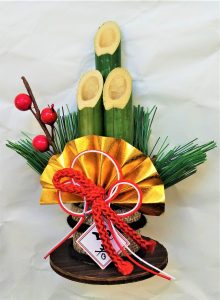
8. San-nezumi Pochi-bukuro Envelopes
made from Mino-Washi (1 item)
In Japan, pochi-bukuro envelopes are used for children’s New Year’s monetary gifts “Otoshi-dama” tip, and message cards envelopes and other congratulation purposes.
9. Nisshin “Donbei” mini Duck soup stock flavor (1p)
Best Before 1 Apr 2020
Common Allergens : Wheat, buckwheat, egg, milk, pork, chicken, soy.
“Donbei” is very popular instant soba (buck wheat) in Japan.
Please experience “Toshi-koshi soba” on the evening of December 31st!
10. Post card “Kagami-mochi” (1 item)
This is a postcard of “Kagami-mochi” and “Ise-ebi” (Auspicious lobster) which is indispensable for New Year’s Day.

The Number of items: 10.
The SNACK Box
1. Fukufuku Tai (1p)
This is “Tai” (red snapper)-shaped wafer chocolate.
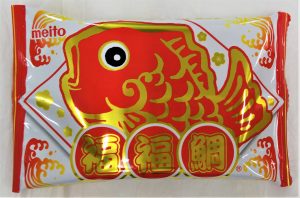
2. Ebi Sakusaku-nikki (1P)
It imitates the “shrimp” of the “Osechi dish”.
Shrimp is a wish for longevity.
3. “Hamakaze” Snack Kelp (1P)
It is like “Kobu-maki” of the “Osechi dish”.
“Kobu-maki” is a wish for joy.
4. Kuromame shibori (1P)
It imitates “Kuro-mame” of the “Osechi dish”.
“Kuro-mame” is a desire to live healthily.
5. Ko-Haku Wasanbon (1P)
It imitates “Kamaboko” of the “Osechi dish”.
In Japan, the color of “red and white” is a combination of happy times.
“Wasan-bon” is a kind of Japanese traditional sugar.
We will eat it as a special sweet.
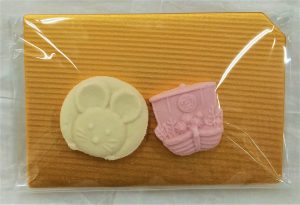
6. Almond fish (4P)
It imitates “Ta-tsukuri” of the “Osechi dish”.
“Ta-tsukuri” is a wish for a fruitful year.
7. Lotus root chips (1P)
It imitates “Pickled lotus root” of the “Osechi dish”
The lotus root is a hope for a future with good prospects.
8. ”Enakko” (1P)
This sweet is made from the chestnuts of Japanese production.
It imitates “Kuri-kinton” of the “Osechi dish”.
“Kuri-kinton” wishes you a prosperous business.
9.”Amida-ike Daikoku” Iwa-okoshi (5P)
“Okoshi” is one of the traditional Japanese sweets.
This sweet is derived from the auspicious “Daikokuten (God of Property)”.
10.”Shichi-fukujin” Assorted Rice Crackers (1p)
“Shichi-fukujin” are the seven lucky God that is believed in Japan to bring happiness.
This rice cracker is in an auspicious package.
11. Koike-ya “PRIDE POTETO” (1p)
This is a potato chip with 100% Japanese potatoes and full-fledged ingredients that take advantage of the taste of Ise Ebi (shrimp) and sweet shrimp from Mie Prefecture.
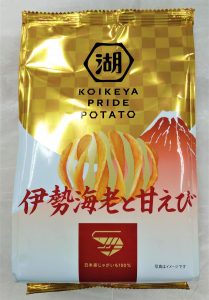
12. “Chorogi” (Japanese artichoke) plum taste(1p)
“Chorogi” is familiar in Osechi dishes. this “Chorogi” has been made into a
package that can be eaten as if it were a snack.
13. Post card “Zou-ni” (rice cake soup) (1p)
This postcard is an illustration of “Zou-ni” (rice cake soup).
“Zou-ni” is essential for the New Year.

The Number of items: 20.
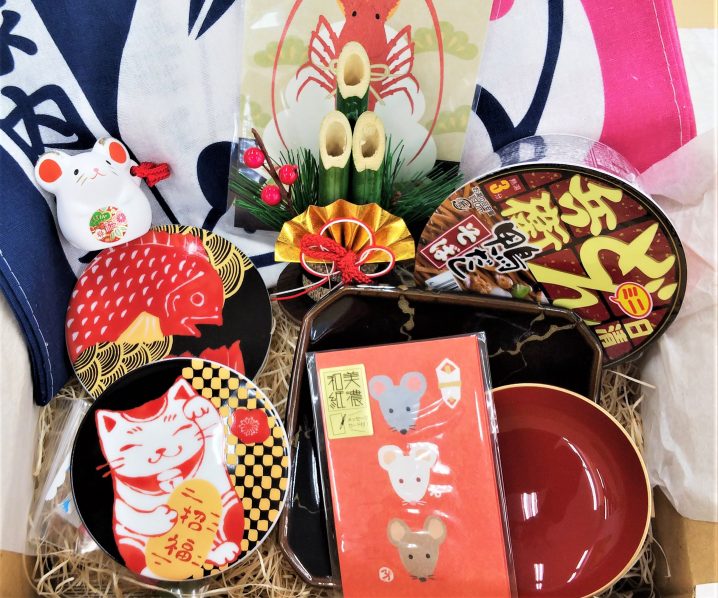
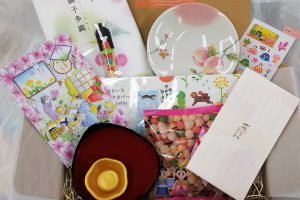
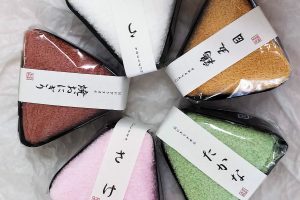
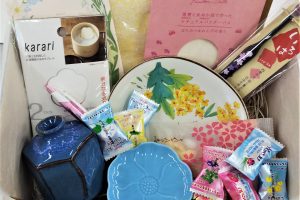

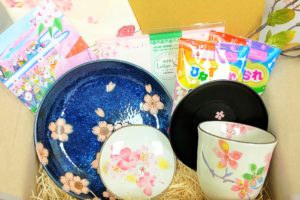
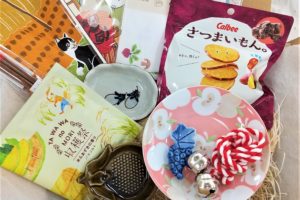
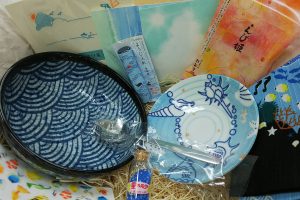
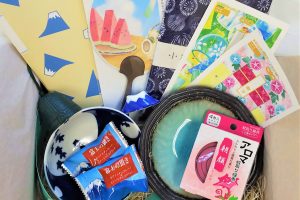
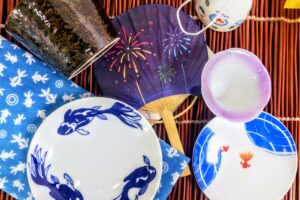
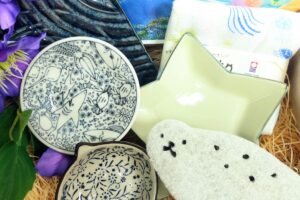
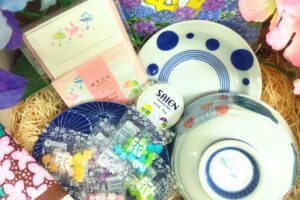
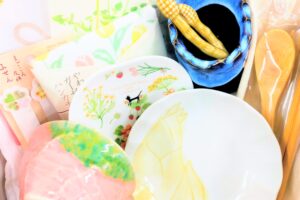
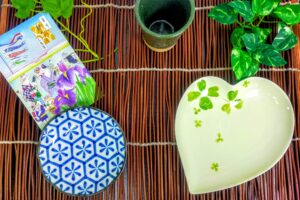
Recent Comments